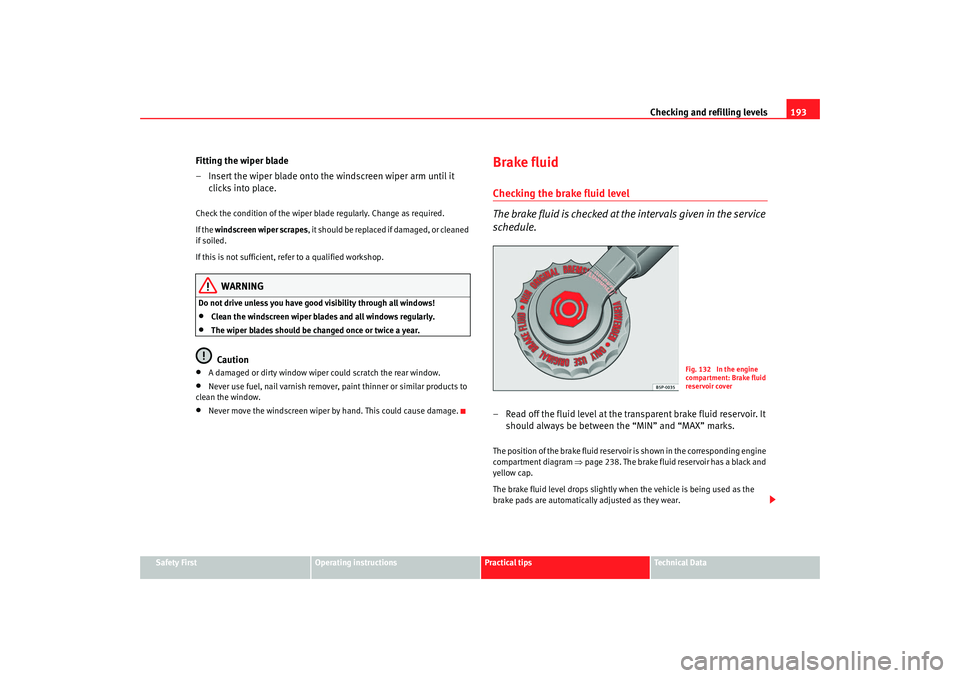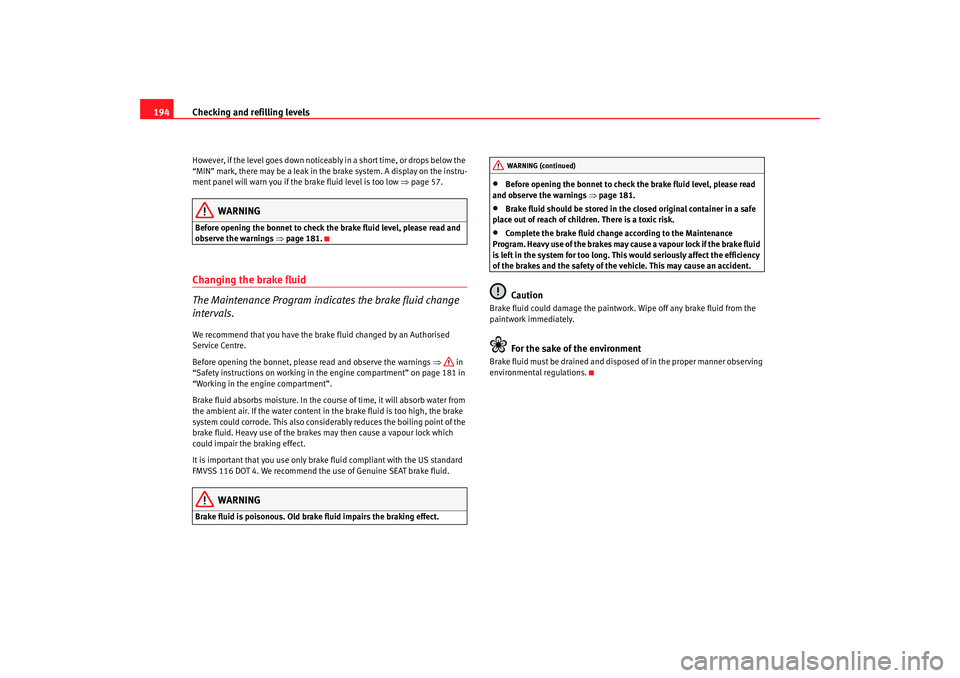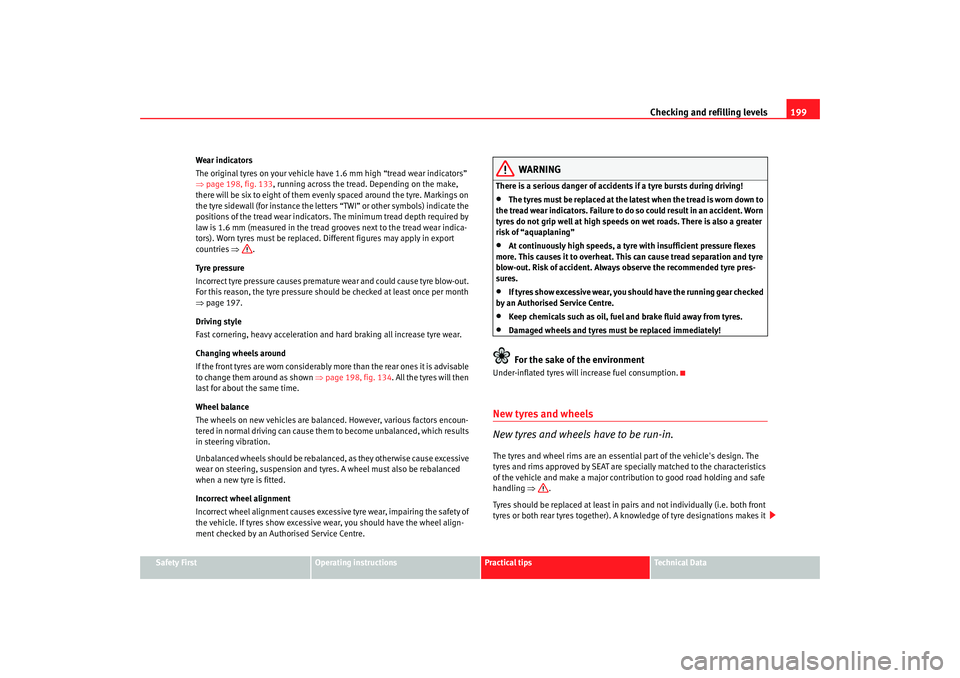Page 195 of 260

Checking and refilling levels193
Safety First
Operating instructions
Practical tips
Te c h n i c a l D a t a
Fitting the wiper blade
– Insert the wiper blade onto the windscreen wiper arm until it
clicks into place.Check the condition of the wiper blade regularly. Change as required.
If the windscreen wiper scrapes, it should be replaced if damaged, or cleaned
if soiled.
If this is not sufficient, refer to a qualified workshop.
WARNING
Do not drive unless you have good visibility through all windows!•
Clean the windscreen wiper blades and all windows regularly.
•
The wiper blades should be changed once or twice a year.Caution
•
A damaged or dirty window wiper could scratch the rear window.
•
Never use fuel, nail varnish remover, paint thinner or similar products to
clean the window.
•
Never move the windscreen wiper by hand. This could cause damage.
Brake fluidChecking the brake fluid level
The brake fluid is checked at the intervals given in the service
schedule.– Read off the fluid level at the transparent brake fluid reservoir. It should always be between the “MIN” and “MAX” marks.The position of the brake fluid reservoir is shown in the corresponding engine
compartment diagram ⇒page 238. The brake fluid reservoir has a black and
yellow cap.
The brake fluid level drops slightly when the vehicle is being used as the
brake pads are automatically adjusted as they wear.
Fig. 132 In the engine
compartment: Brake fluid
reservoir cover
Ibiza250_angles Seite 193 Dienstag, 5. August 2008 1:11 13
Page 196 of 260

Checking and refilling levels
194However, if the level goes down noticeably in a short time, or drops below the
“MIN” mark, there may be a leak in the brake system. A display on the instru-
ment panel will warn you if the brake fluid level is too low ⇒page 57.
WARNING
Before opening the bonnet to check the brake fluid level, please read and
observe the warnings ⇒ page 181.Changing the brake fluid
The Maintenance Program indicates the brake fluid change
intervals.We recommend that you have the brake fluid changed by an Authorised
Service Centre.
Before opening the bonnet, please read and observe the warnings ⇒ in
“Safety instructions on working in the engine compartment” on page 181 in
“Working in the engine compartment”.
Brake fluid absorbs moisture. In the cour se of time, it will absorb water from
the ambient air. If the water content in the brake fluid is too high, the brake
system could corrode. This also considerably reduces the boiling point of the
brake fluid. Heavy use of the brakes may then cause a vapour lock which
could impair the braking effect.
It is important that you use only brake fluid compliant with the US standard
FMVSS 116 DOT 4. We recommend the use of Genuine SEAT brake fluid.
WARNING
Brake fluid is poisonous. Old brake fluid impairs the braking effect.
•
Before opening the bonnet to check the brake fluid level, please read
and observe the warnings ⇒page 181.
•
Brake fluid should be stored in the closed original container in a safe
place out of reach of children. There is a toxic risk.
•
Complete the brake fluid change according to the Maintenance
Program. Heavy use of the brakes may cause a vapour lock if the brake fluid
is left in the system for too long. Th is would seriously affect the efficiency
of the brakes and the safety of the vehicle. This may cause an accident.Caution
Brake fluid could damage the paintwork. Wipe off any brake fluid from the
paintwork immediately.
For the sake of the environment
Brake fluid must be drained and disposed of in the proper manner observing
environmental regulations.
WARNING (continued)
Ibiza250_angles Seite 194 Dienstag, 5. August 2008 1:11 13
Page 201 of 260

Checking and refilling levels199
Safety First
Operating instructions
Practical tips
Te c h n i c a l D a t a
Wear indicators
The original tyres on your vehicle have 1.6 mm high “tread wear indicators”
⇒
page 198, fig. 133 , running across the tread. Depending on the make,
there will be six to eight of them evenly spaced around the tyre. Markings on
the tyre sidewall (for instance the letters “TWI” or other symbols) indicate the
positions of the tread wear indicators. The minimum tread depth required by
law is 1.6 mm (measured in the tread grooves next to the tread wear indica-
tors). Worn tyres must be replaced. Different figures may apply in export
countries ⇒.
Tyre pressure
Incorrect tyre pressure causes premature wear and could cause tyre blow-out.
For this reason, the tyre pressure should be checked at least once per month
⇒ page 197.
Driving style
Fast cornering, heavy acceleration and hard braking all increase tyre wear.
Changing wheels around
If the front tyres are worn considerably more than the rear ones it is advisable
to change them around as shown ⇒page 198, fig. 134 . All the tyres will then
last for about the same time.
Wheel balance
The wheels on new vehicles are balanced. However, various factors encoun-
tered in normal driving can cause them to become unbalanced, which results
in steering vibration.
Unbalanced wheels should be rebalanced, as they otherwise cause excessive
wear on steering, suspension and tyres. A wheel must also be rebalanced
when a new tyre is fitted.
Incorrect wheel alignment
Incorrect wheel alignment causes excessive tyre wear, impairing the safety of
the vehicle. If tyres show excessive wear, you should have the wheel align-
ment checked by an Authorised Service Centre.
WARNING
There is a serious danger of accidents if a tyre bursts during driving!•
The tyres must be replaced at the latest when the tread is worn down to
the tread wear indicators. Failure to do so could result in an accident. Worn
tyres do not grip well at high speeds on wet roads. There is also a greater
risk of “aquaplaning”
•
At continuously high speeds, a tyre with insufficient pressure flexes
more. This causes it to overheat. This can cause tread separation and tyre
blow-out. Risk of accident. Always observe the recommended tyre pres-
sures.
•
If tyres show excessive wear, you should have the running gear checked
by an Authorised Service Centre.
•
Keep chemicals such as oil, fuel and brake fluid away from tyres.
•
Damaged wheels and tyres must be replaced immediately!For the sake of the environment
Under-inflated tyres will increase fuel consumption.New tyres and wheels
New tyres and wheels have to be run-in.The tyres and wheel rims are an essential part of the vehicle's design. The
tyres and rims approved by SEAT are specially matched to the characteristics
of the vehicle and make a major contribution to good road holding and safe
handling ⇒.
Tyres should be replaced at least in pair s and not individually (i.e. both front
tyres or both rear tyres together). A knowledge of tyre designations makes it
Ibiza250_angles Seite 199 Dienstag, 5. August 2008 1:11 13
Page 242 of 260
Technical Data
240Trailer weights
Engine oil capacityPetrol engine 1.4l 63 kW (85 bhp)Engine specifications
Performance figures Trailer without brakes
530
Trailer with brakes, gradients up to 8% 1000
Trailer with brakes, gradients up to 12% 800
Approximate engine oil capacity with oil filter change 2.75 litres
Power output in kW (bhp) rpm 63 (85)/ 5000
Maximum torque in Nm at rpm 132/ 3800
No. of cylinders, capacity in cm
3
4/ 1390
Compression 10,5 +/- 0,5
Fuel Super 95 RON
a)/Normal 91 RON
b)
a)Research- Octane- Number = Measure of the antidetonator petrol power.b)Slight power lossMaximum speed in km/h 175
Acceleration from 0-80 km/h in sec. 8
Acceleration from 0-100 km/h in sec. 12,2
Ibiza250_angles Seite 240 Dienstag, 5. August 2008 1:11 13
Page 243 of 260
Technical Data241
Safety First
Operating instructions
Practical tips
Te c h n i c a l D a t a
Weights
Trailer weights
Engine oil capacity
Petrol engine 1.6l 77 kW (105 bhp)Engine specifications
Gross vehicle weight
in kg 1526
Weight in working order (with driver) in kg 1100
Front gross axle weight in kg 860
Rear gross axle weight in kg 780
Permitted roof load in kg 75
Trailer without brakes: 550
Trailer with brakes, gradients up to 8% 1200
Trailer with brakes, gradients up to 12% 1000
Approximate engine oil capacity with oil filter change 2.8 litres
Power output in kW (bhp) rpm 77 (105)/5 600
Maximum torque in Nm at rpm 153/ 3800
No. of cylinders, capacity in cm
3
4/ 1598
Compression 10,5+/- 0,2
Fuel Super premium unleaded 98 octanes/ Super 95 ROZ/Normal 91 ROZ
a)
a)With a slight power loss
Ibiza250_angles Seite 241 Dienstag, 5. August 2008 1:11 13
Page 244 of 260
Technical Data
242Performance figures
Weights
Trailer weights
Engine oil capacity Maximum speed
in km/h 187
Acceleration from 0-80 km/h in sec. 6,9
Acceleration from 0-100 km/h in sec. 10,5
Gross vehicle weight in kg 1541
Weight in working order (with driver) in kg 1115
Front gross axle weight in kg 860
Rear gross axle weight in kg 780
Permitted roof load in kg 75
Trailer without brakes 550
Trailer with brakes, gradients up to 8% 1200
Trailer with brakes, gradients up to 12% 1000
Approximate engine oil capacity with oil filter change 3.3 litres
Ibiza250_angles Seite 242 Dienstag, 5. August 2008 1:11 13
Page 246 of 260
Technical Data
244Trailer weights
Engine oil capacityDiesel engine 1.9l TDI 66 kW (90 bhp)Engine specifications
Performance figures Trailer without brakes
580
Trailer with brake in gradients up to 8% 1200
Trailer with brakes, gradients up to 12% 1000
Approximate engine oil capacity with oil filter change 3.9 litres
Power output in kW (bhp) rpm 66 (90)/ 4000
Maximum torque in Nm at rpm 210/ 1800-2500
No. of cylinders, capacity in cm
3
4/ 1896
Compression 18,5:1
Fuel Min. 51 CN
a)
a)Cetane- Number (cetane index) = Measure of the diesel combustion power.Maximum speed in km/h 176
Acceleration from 0-80 km/h in sec. 8
Acceleration from 0-100 km/h in sec. 12
Ibiza250_angles Seite 244 Dienstag, 5. August 2008 1:11 13
Page 247 of 260
Technical Data245
Safety First
Operating instructions
Practical tips
Te c h n i c a l D a t a
Weights
Trailer weights
Engine oil capacity
Diesel engine 1.9l TDI 77 kW (105 bhp)Engine specifications
Gross vehicle weight
in kg 1626
Weight in working order (with driver) in kg 1200
Front gross axle weight in kg 940
Rear gross axle weight in kg 780
Permitted roof load in kg 75
Trailer without brakes 600
Trailer with brakes, gradients up to 8% 1200
Trailer with brakes, gradients up to 12% 1200
Approximate engine oil capacity with oil filter change 4 litres
Power output in kW (bhp) rpm 77 (105)/ 4000
Maximum torque in Nm at rpm 240/ 1900
No. of cylinders, capacity in cm
3
4/ 1896
Compression 18,5
Fuel Min. 51 CN
a)
a)Cetane- Number (cetane index) = Measure of the diesel combustion power.
Ibiza250_angles Seite 245 Dienstag, 5. August 2008 1:11 13